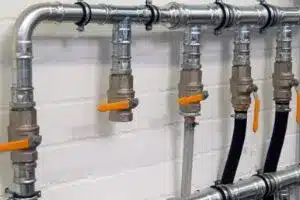Commercial plumbing systems are commonly found in industrial, office, and institutional buildings such as hospitals, schools, hotels, restaurants, and retail stores. These systems may also be present in public buildings such as office buildings, city halls, and libraries; apartment buildings; townhouses; mobile homes; dormitories; military facilities; and other types of dwellings.
Commercial plumbing systems must meet federal and state codes that regulate their construction and installation in order to protect the health and safety of those using them. There are 8 steps involved in determining commercial plumbing system requirements:
1) Determine the Scope of Work
Once you’ve decided to move forward with a commercial project, your next step is determining exactly what work will be required. The scope of work (SOW) will change based on your customer’s needs, but as a general rule, it should answer these questions:
- Which systems will we replace or repair?
- Will new piping need to be installed in any areas that are being renovated?
- How long is each phase of our renovation expected to take so we can budget accordingly?
2) Check Permits and Codes
Before diving in, make sure you’ve checked your city or county’s zoning and building codes for any commercial plumbing regulations. For example, most jurisdictions require a permitted plumber when installing new pipes within a certain distance of property lines or other infrastructure. (The required distance will vary depending on local codes.) You should also check with your state’s commercial builder licensing board for any pertinent regulations regarding your project before getting started.
3) Schedule Design Consultants
The first step in determining your commercial plumbing system’s requirements is consulting with a licensed commercial design consultant. Your consultant will begin by reviewing your building’s blueprints and meeting with you and any potential contractors. From there, they’ll prepare a schematic diagram that maps out all of your proposed space’s dimensions and flow paths.
4) Review or Update Plans
Before you can put your commercial plumbing systems into operation, you need to take a critical look at all of your plans. Make sure they’re updated and in order before finalizing any part of your installation process. This is often an overlooked step, but one that could be extremely costly later on down the line if it’s not handled now. Things like changes in code or facilities could result in major issues for you if you don’t ensure everything is up-to-date from start to finish.
5) Order Materials and Equipment
Regardless of how you choose to install your commercial plumbing systems, you’ll need materials and equipment. Make sure you order these things ahead of time and have them ready for installation on move-in day so that you don’t risk running into problems with delays. Luckily for you, when you work with Bulldog Rooter, we assist in the entire Commercial Plumbing System Installation process from start to finish! If you have a new building with limited plumbing systems, or you’re building from the ground up, we’ve got you covered!
6) Install Fixtures, Pipes, Valves, Sinks, etc.
After determining your commercial plumbing system’s required flow and pressurization, you can now install fixtures, pipes, valves, sinks, etc.
Commercial sinks must be designed to withstand a high volume of traffic – which means they will have larger faucets and drains. Make sure that your faucets exceed 1.5 GPM (gallons per minute) for water flow and 3.5 PSI (pounds per square inch) for pressure; these standards may differ by location.
7) Test Fixtures, Pipes, Valves, Sinks, etc.
One of your first steps when you’re sizing a commercial plumbing system is testing all of your fixtures, pipes, valves, sinks and other components. These tests will help you understand how much water flows through each fixture at its maximum load. You can then take that information and extrapolate it over time (i.e., figuring out how many times people flush or fill their sink each day). Use that information to make a determination about what kind of pipes and valves you’ll need for your building.
8) Complete Final Details
Before you’re ready to sign a contract with a commercial plumber, be sure that all of your questions have been answered and all of your requests honored. Does your contractor provide guarantees or warranties on their work? These details can help ensure that you’ll receive quality service.
If there are any small problems during construction, will they be resolved quickly? Are there certain things that contractors should look out for when completing a project and if so what is it so they don’t miss these details which could end up costing more down the road if missed.
No matter what stage in the process you are of evaluating, building, updating or replacing your commercial properties plumbing system, Bulldog Rooter can help you along the way! From assistant in the building plans, to replacing massive commercial property plumbing systems, we can do it all! Get in contact with Bulldog Rooter today to get started!








